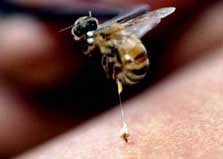
1. Remove the stinger
The first step is to immediately remove the stinger embedded in your skin. It takes just a few seconds for all of the harmful venom to enter your body.
Scrape the sting site with a fingernail or use a pair of tweezers to remove the stinger.
Wash the area with antiseptic soap and water.
Pat dry and apply some antiseptic ointment. You can also apply calamine lotion to ease itching and swelling.
Note: Avoid pinching the stinger, as it will inject more venom into the skin.
2. Apply Ice
The next step is to apply an ice compress on the affected area to get immediate relief from various symptoms.
apply ice on bee or wasp sting
Cold temperature slows the distribution of inflammatory substances to the bite site. It also helps numb the pain as well as reduces swelling.
Put some ice cubes in a thin washcloth and tie it.
Hold this pack on the affected area for 10 to 15 minutes.
Reapply every few hours until the pain and swelling are gone.
You can also hold a cold bottle of water or a bag of frozen vegetables on the affected area.
Note: Never put ice directly on the skin, which can cause frostbite.
3. Baking Soda
Baking soda is an alkaline product that helps neutralize the acidic venom, thus providing quick relief from pain, itching and swelling.
Mix 1 teaspoon of baking soda with a little water to make a paste.
Apply the paste on the sting site for 5 to 10 minutes.
Wash the area with lukewarm water.
If the discomfort persists, repeat the remedy after a few hours.
4. Witch Hazel
Witch hazel is another effective natural remedy for bee or wasp stings. Due to its anti-inflammatory and astringent properties, it helps ease the itching, pain and swelling.
Dab a little witch hazel (preferably chilled in the refrigerator) on the affected area and allow it to dry on it own.
Repeat as needed.
5. Apple Cider Vinegar
Apple cider vinegar also helps neutralize the acid in the venom. It also eases pain and reduces itching and swelling.
Soak a cotton ball in raw, unfiltered apple cider vinegar.
Hold the cotton ball over the welt for 5 to 10 minutes.
Repeat as needed.
If you do not have apple cider vinegar, you can use white vinegar.
6. Honey
Honey is another good remedy for bee stings. It helps dilute the venom and its antibacterial nature reduces the risk of infection. The soothing nature of honey helps alleviate symptoms quickly.
Smear a little pure, raw honey on the affected area, allow it to dry and then rinse it off with warm water. Repeat a few times a day.
You can also mix equal amounts of raw honey and turmeric to make a paste. Apply it on the affected area, a few times daily for a few days.

